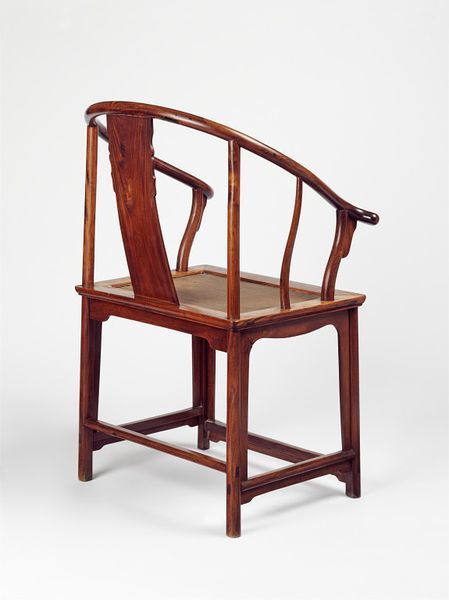明代の椅子 / chair in Ming style
昨日、Victoria & Albert Museumの「Friday Late」で開催された『The Secret Life of Furniture』というイベントの中で、17世紀後半に作られた中国の椅子についてトークをしました。昨年12月にオープンしたFurniture Galleryに展示されている家具の中から2点選んで話をしてください、と依頼され、自作の家具Table=Chestについてはいくらでも話せるのでまず選び、次にこの明代の椅子を選んだのは、この椅子に惹かれる理由を自分でも知りたかったからでした。
専門家が素材や技術について分析した資料を読み、自分なりの視点をつけ加えて話そうと準備をしたのですが、イベントが終わってみると学習した多くのことについて話すのを忘れていて、なんだか消化不良だったなぁ、、、と思うので、V&Aに来られなかった方のためにも、忘れないうちに書き残すことにします。
I gave a talk yesterday at a part of the V&A ‘Friday Late’ events, on two pieces of furniture in their new Furniture Gallery. One of them was Chinese chair in Ming Dynasty style. I have chosen this piece of furniture because I wanted to discover myself why I am attracted by this chair – to pinpoint aspects of interests and learn more about its charm.
I have read some articles on Chinese furniture in that time, to prepare and add my point of view at the talk. Now, after the talk I feel that I did not describe at all about the beauty of the chair… So, I would like to write it down here, for the people who did not make to attend the V&A as well.
***
これがV&Aのアーカイブに載っている展示品(推定1600-1700)の写真です。
Below are the V&A’s official photos in their archive.
「部材は接着されていない」という記述にまず驚きました。素材はHuali Woodと呼ばれるローズウッドに近い硬木で、それを「mortise & tenon(ほぞとほぞ穴)」で組み合わせ、くさびを打ち込むことで固定しています。実物を見ると、たとえば座面下の「たれ」の部分やそれとつながる薄く削られた木材の補強材なども、脚部にくった溝に差し込み、足を載せる横棒が「mortise & tenon」で止まっていることで、補強の必要な場所に固定されていることが分かります。
この椅子が作られた明代(1368-1644年)の後半から清代の前半にかけては、倭冦と呼ばれた海賊が沿岸部を攻め、満州には後金が興って北から明をおびやかすなど、戦乱が続いていたので、この椅子を所有していた高級官僚は広い中国をあちこち旅する生活だったのではないでしょうか。この椅子は、そんな貴人の生活用具として運ばれるためにできるだけ軽く、気温や湿度が極端に違う場所でも調整が効くように作られていた。乾燥した土地に着いて木が縮み、部材がゆるんでガタガタしはじめたらくさびを大きいものに変えて打ち直し、座りを良くしたことが想像できます。
エレガントな曲線を描く肘あてと背もたれのつながりは「half lapped pressure peg joint」と説明されている繋ぎ手で組まれた5つの部材から作られています。これは、寺院建築などで日本でも使われた継ぎ手で、斜めに重なった2つの部材の真ん中にくさびが差し込まれています。4箇所の繋ぎ手が、背もたれの縦の板の両側と美しくカーブを描く肘あて下の細い縦材(手前から数えて2本目)の上に配置されているのですが、この先が細くなっている縦材が気温や湿度による動きやひずみを緩衝することで、特徴的な円周はいつもおおらかな線を保つことができたのだと思われます。
移動に配慮した軽さと、そのための構造を補強する部材にひかえめにほどこされた気品ただよう装飾。どうやらこの2点が、わたしがこの椅子に惹かれている理由だったようです。
このタイプの椅子から直接インスピレーションを受けたハンス・ウェグナーの1943年デザイン「Chinese Chair」については、またいつかの機会に。
***
First of all I am caught by the part of the text – Nothing is glued, but all parts are connected with Mortise & Tenon joints. The material is called Huali Wood, has similar character to Rosewood. Even structural support, such as apron and frames under the seat, are all trapped into grooves by the lower stretcher with Mortise and Tenon. The lowest stretcher has wide top and it is a footrest.
At the end of Ming Dynasty, the owner of this chair must have had busy travelling life, as a hight bureaucrat who had to take care of Wokou pirates and the rising Northern nation Qing on behalf of the emperor. This is why the chair had to be light and flexible. In cold and dry climate the solid wood shrank a lot and the joints starts to be loosened, the chair will be wobble. You can stop it by changing the size of the wedge in those joints.
The prominent large curved piece of armres-to-back is made by 5 jointed solid piece, by a technique called ‘half lapped pressure peg joint’, which was often used in Japanese temple architecture. Four joints are located next to the both sides of the wide vertical back rest, as well as top of elegantly bent vertical supports of armrests. I guess these tapered shape of the supports are flexible enough to absorb the movement of wood and retained the shape of the single curving structure.
The lightness for mobility, and their playful and modest decorations to disguise the structural support – these two points are making this chair charming and attract me a lot.
In the future I will research its direct descendant “Chinese Chair”, designed in 1943 by Hans Wegner.


